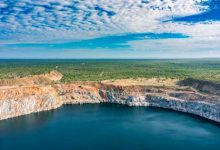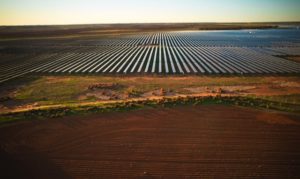Sometime in the next month or two, the first investment in what will be a significant new stage in the transition to a renewable energy dominated grid in Australia will be made.
It will be confirmation of the world’s first investment in a project that co-locates, for the first time, large-scale solar with a large-scale pumped hydro storage facility – and the first example in Australia of a storage facility with vastly more storage capacity than the renewable energy source it is paired with.
Storage is a new phenomenon in Australia – even though there are a handful of pumped hydro plants scattered around the main grid, from Wivenhoe in the north, to Shoalhaven and Tumut in NSW.
There has been extraordinary interest in the performance of the country’s first large-scale battery, the so-called Tesla big battery at Hornsdale, which is also the world’s biggest lithium-ion installation.
This, and the Newman battery in the Pilbara, have stunned observers with the speed, accuracy and flexibility, challenging the primacy of the fossil fuel industry in providing both frequency and inertia, and defying the assumption that you need fossil fuels to keep the grid intact.
One expects as much excitement and scrutiny of the Genex project at Kidston, although that won’t be the only project that is due to get an investment nod around that time. Snowy Hydro is also working feverishly on its own grand plans to recreate the splendor of the original hydro scheme and add a $6 billion plus project to be known as Snowy 2..0
It is not entirely clear, however, that the investment decision to be taken by early December will be a commitment to the whole project, the 2,000MW facility with 175 hours of storage, or to fund extensive tunnelling that will then form the basis of further investment.
Whatever the case, these are not the only pumped hydro schemes that are being looked at in detail.
Hydro Tasmania, with the enthusiastic support of the state government, is looking at its own extensive pumped hydro plans to dovetail with increased wind energy and new transmission lines to the mainland to become the “battery of the nation”.
Meanwhile, five different projects are being investigated in South Australia, at least one more is under consideration in NSW, and some existing pumped hydro projects are also looking at revival or expansion.
But first to the north.
The Kidston project will combine 250MW of pumped hydro capacity, with eight hours of storage, installed in the old Kidston gold mine in the north of Queensland, and sited next to a new 270MW solar farm, as well as the existing 50MW solar farm that was switched on a few months ago.
State planning minister Cameron Dick has already announced that the project had been awarded “co-ordinated project “ status, saying the introduction of large-scale, low-cost flexible energy storage also provides another solution to Queensland’s growing power requirements.
The Northern Australian Infrastructure Facility has also promised $500 million, and Genex is now working on delivering off-take agreements for the new solar plant and the pumped hydro facility so it can land the rest of the financing.
 The Snowy 2.0 pumped hydro scheme is at another scale – a bold plan that aims to 2000MW of capacity and 175 hours of storage to the national grid – likely at a cost of more than $6 billion, plus transmission infrastructure.
The Snowy 2.0 pumped hydro scheme is at another scale – a bold plan that aims to 2000MW of capacity and 175 hours of storage to the national grid – likely at a cost of more than $6 billion, plus transmission infrastructure.
Energy minister Angus Taylor is new to the job, but can be counted on as a fan. His grandfather was the chief engineer of the original Snowy Hydro scheme, and it’s highly likely that pumped hydro will fulfill the government desire for what it calls “fair dinkum” power generation (even if it is storage).
Given the amount of coal-fired generation that is due to retire over the next 20 years (see graph above), the share of storage required (marked in purple) is significant, particularly as solar becomes the largest contributor to the grid.
The Tasmanian government is looking to support its own major scheme – the with plans to become the “renewable battery” for the state of Victoria.
“Coal is retiring, and as new sources of renewable energy like wind and solar are cheap and becoming more plentiful we need to maintain energy reliability, stability and security by investing in dispatchable capacity,” says Hydro Tasmania CEO Steven Davy.
“Pumped hydro will form a huge part of that. It represents the next generation of Tasmanian hydropower, and (allows) us re-use our hydro water again and again to create clean energy.”
Private companies are also looking at pumped hydro, and mostly in South Australia, which is now moving on from a share of more than 50 per cent wind and solar in its local generation, to a level closer to 100 per cent by 2025.
This share of renewable energy, of course, requires significantly more storage. And at least five pumped hydro storage projects are being looked at, along with a string of battery storage and hydrogen storage projects.
The fate of many may depend on decisions taken elsewhere, such as the construction of a new transmission link from South Australia to Wagga Wagga in NSW. Observers say that because of the relatively small nature of the South Australia grid, it is likely that only one project will get the go-ahead in the short term.
Those competing are:
– The Middleback Ranges. Sanjeev Gupta’s Simec Zen Energy is looking at using abandoned iron ore mines as reservoirs for a major pumped hydro project that will be a key component of his plans for 1GW of solar and storage to power the Whyalla steelworks and other large energy consumers in the state.
That project was originally seen as a 90MW/390MWh pumped hydro facility at the old Iron Duchess mine but the talk is that this capacity could be doubled.
– Elsewhere, Altura Group is advancing the Goat Hill project, 12km west of Port Augusta, where it and Delta Electricity are looking at a pumped hydro project of 230MW in capacity and 1840MWh of storage.
– Rise Renewables, chaired by former CEFC boss Oliver Yates, is looking at a 200-230MW/1600MWh pumped hydro project at the existing Baroota Reservoir, north-east of Port Germein.
– EnergyAustralia, as previously foreshadowed, is looking at , although in this case it will use sea water.
– And in the Adelaide Hills, Tilt Renewables is looking at a major 400MW, 1150MWh pumped hydro project in an old quarry in the Adelaide foothills.
How these projects are developed will depend on their individual cost profiles and potential business model, the proposed new transmission link to Wagga Wagga in NSW, and the “first mover” advantage – the theory that the first to be built can capture most of the available spoils in the market.
For the second and third pumped hydro projects, and so on, it depends on how the transition is managed. Is there a planned exit of ageing coal and gas-fired generators or not, where are the signals?
In NSW, there is the Oven Mountain Pumped Hydro project – 600MW with six hours storage – that is being considered for an area around the mountain of the same name between Armidale and Kempsey.
In Victoria, there is study looking at an old gold mine in Bendigo, using deep shafts to create a 30MW facility with 180MWh of storage. Other disused mines in the state are also being studied.
Some environmental groups suggest that the coal pits in the Latrobe Valley could be excellent sites for future pumped hydro facilities, and even in the small town of Mullumbimby, there are hopes of reviving the small hydro plant as part of that community’s hope of becoming 100 per cent renewable.
Origin Energy is also looking to expand its Shoalhaven pumped hydro facility and double its size with the additional of two new turbines.
“With more renewables in the system, Shoalhaven looks like an obvious, a really good investment,” Origin Energy’s head of energy trading and operations Greg Jarvis told RenewEconomy in a recent episode of the Energy Insiders podcast.
“Shoalhaven is a pretty good investment in its own right, and it’s a good fit for system. The transmission capacity is there and it has got spare capacity.” Origin is currently embarking on a pre-feasibility study for the expansion project.
The Wivenhoe pumped hydro facility in northern Queensland is another interesting example. It has been around for decades, but as ITK analyst David Leitch has pointed out, is rarely used.
That may change next year when the plan is to put Wivenhoe and other “clean energy” assets into a new government-owned generation company to compete against the dominant “coalers”.
That creates a fascinating prospect, not just of being used to balance out the output from wind and solar farms in the portfolio and contracted, but also playing the peak arbitrage market as an independent player.
Certainly, pumped hydro will form a central part of the Australian Energy Market Operator’s plans for extensive storage as the country accelerates its shift to a grid dominated by renewables.
- “The delivered cost of energy from wind and solar in combination with storage from pumped hydro and batteries is anticipated to be lower than generation based on new coal or natural gas when the existing coal generators retire,” AEMO notes in its recent draft Integrated System Plan.
The question, though, is how and when the replacements should be built. The future – 100 per cent renewables, or near as dammit – would be easier to construct from a standing start than managing a transition. Storage will play a critical role, but so too will the policy makers, market rule makers and investors who can enable it.
This is the fifth and last of a series on pumped hydro sponsored by GE, including a special episode of Energy Insiders podcast on the subject.
The other articles can be found here:
A deep-dive into the evolution of pumped-hydro energy storage technology
Answers to 7 key questions on pumped-hydro storage
The role of pumped-hydro storage in a 100% renewable world
Women in hydro, and why more are needed: “Women and men don’t think the same way”










